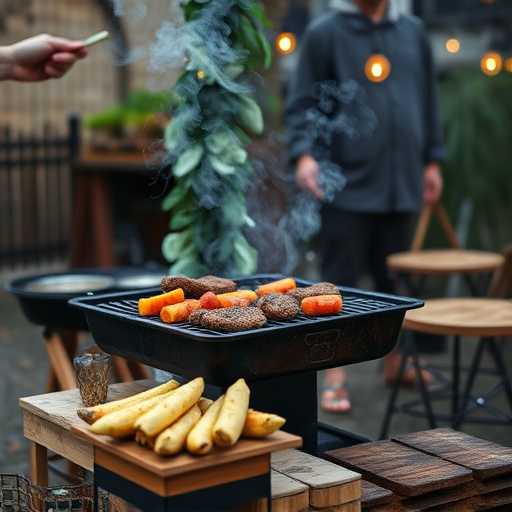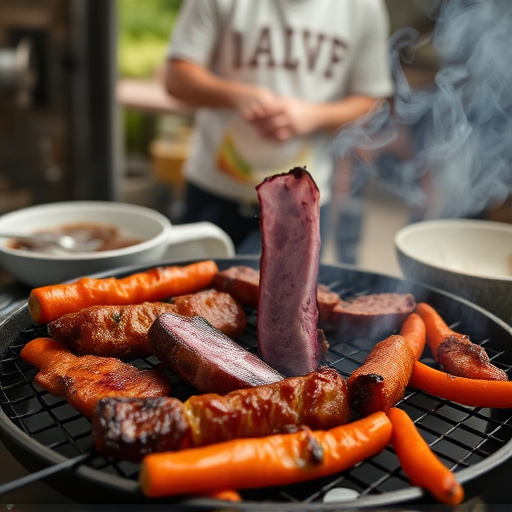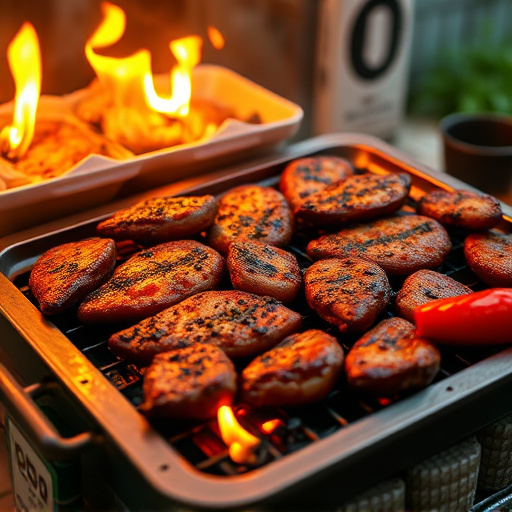Crafting perfect BBQ beef jerky involves selecting lean cuts like round or flank steak, balancing marbling for richness, and slicing against the grain. Create a flavorful marinade with vinegar, oil, garlic, paprika, salt, pepper, sugar, liquid smoke, chili flakes, smoked paprika, onion powder, and honey for tenderization. Dry meat at 135°F (57°C) to achieve crispy texture. Choose grilling, smoking, or air-drying for distinct flavors. Store in airtight containers or sealed wrap for up to 2 months at 40°F (4°C). Experiment with spices like smoked paprika, chipotle, brown sugar, cayenne, garlic, soy sauce, and honey for unique tastes. Healthier DIY option with less added sugar and sodium for energy boost.
“Transform your barbecue experience with the art of making homemade BBQ beef jerky—a delicious, crunchy treat. This comprehensive guide takes you on a journey from selecting the ideal cut of beef for jerky to crafting mouth-watering marinades and mastering drying techniques. Learn the secrets behind spicy, savory flavors and discover versatile variations to suit every palate. With tips on storage and cooking methods, you’ll create a perfect BBQ beef jerky recipe that’s not only tasty but also packed with health benefits.”
- Selecting the Perfect Cut of Beef for Jerky
- The Art of Marinating: A Step-by-Step Guide
- Spicy and Savory: Crafting Your BBQ Marinade
- Drying Techniques to Achieve Crunchy Jerky
- Cooking Methods for Flavorful Results
- Tips for Storage and Shelf Life
- Creative Variations for Unique Flavors
- Health Benefits of Homemade Beef Jerky
Selecting the Perfect Cut of Beef for Jerky

When crafting your ideal BBQ beef jerky recipe, choosing the right cut of meat is paramount. The perfect candidate should be lean yet flavorful, allowing for a delightful balance between tender texture and robust taste. Opting for trim cuts like round steak or flank steak can yield exceptional results. These cuts have less fat and connective tissue, ensuring a milder flavor profile that pairs beautifully with your favorite barbecue marinade.
Consider the marbling and fat content—a subtle amount adds richness without overwhelming the overall taste. The cutting process is also crucial; thin slices, preferably against the grain, will result in jerky that’s easier to chew and more satisfying. This attention to detail can transform a basic BBQ beef jerky recipe into an exceptional, chewy, and flavorful treat for any occasion.
The Art of Marinating: A Step-by-Step Guide

Marinade is more than just a flavor enhancer; it’s an art that transforms simple strips of beef into mouthwatering BBQ jerky. The process involves a delicate balance of ingredients, allowing the meat to absorb flavors while remaining tender and juicy.
Here’s a step-by-step guide to crafting your perfect bbq beef jerky recipe: Start by combining your chosen vinegar (for acidity) with a base of oil, ensuring the meat stays moist. Add aromatic spices like garlic, paprika, salt, and pepper for depth. Don’t forget sweetener – brown sugar or honey bring a delightful balance. Adjust the quantities based on your preference. For a smoky flavor, include liquid smoke. Stir well to ensure every strip is coated evenly before placing the beef in the marinade for a few hours or even overnight in the fridge.
Spicy and Savory: Crafting Your BBQ Marinade

Creating a mouthwatering BBQ marinade for tender beef strips goes beyond simply slathering on some sauce. It’s an art that blends spicy kick with savory depth, transforming ordinary beef into an irresistible BBQ jerky recipe. Start by balancing heat levels to suit your palate; chili flakes or powder, cayenne pepper, and hot sauce are excellent choices. For the savory element, incorporate ingredients like smoked paprika, garlic powder, onion powder, salt, and black peppercorns for a complex flavor profile.
Don’t forget the acidity and sweetness that help tenderize the meat. Vinegars—white, apple cider, or even rice vinegar—and brown sugar, honey, or maple syrup contribute these elements while adding their own unique tastes. Combine these components in a marinade bath, let it steep, and you’ll have the foundation for beef jerky that’s both spicy and savory, perfect for any BBQ lover looking for a satisfying snack.
Drying Techniques to Achieve Crunchy Jerky

To achieve that crispy, crunchy texture in your BBQ beef jerky recipe, proper drying techniques are essential. After marinating your tender strips of beef, it’s time to remove excess moisture for successful jerky preparation. One effective method is to pat the meat dry with paper towels before hanging it up to air dry. This initial step helps absorb some of the liquid, creating a better texture during the drying process.
Once hung, allow the jerky to air dry at room temperature for several hours or overnight. Alternatively, you can speed up the process using a food dehydrator set at around 135°F (57°C). Regularly check and flip the meat strips to ensure even drying and prevent sticking. The result will be tender, flavorful BBQ beef jerky with that coveted crispy exterior.
Cooking Methods for Flavorful Results

For flavorful and tender strips of BBQ beef jerky, understanding different cooking methods is key. Start by marinating your beef strips in a delicious bbq beef jerky recipe—this step allows flavors to penetrate deep into the meat. After marination, you have several options: grilling, smoking, or even air-drying.
Grilling gives an intense heat that seals in juices and adds charred notes. Smoking, on the other hand, offers a slower, gentler approach, infusing meat with smoky aromas. Air-drying is a traditional method that takes longer but results in a lean, durable jerky perfect for long-term storage. Each technique contributes to a unique, mouthwatering BBQ beef jerky experience.
Tips for Storage and Shelf Life

Storing tender strips of barbecue-marinated beef properly is key to maintaining its quality and safety, especially if you’re preparing a BBQ beef jerky recipe. Once marinated, store the meat in an airtight container or wrap it tightly in plastic wrap or foil. Refrigerate immediately to slow down bacterial growth. In the fridge, these strips can typically last for 3-4 days. For longer storage, consider freezing. Frozen bbq beef jerky will keep for up to 2 months, ensuring a delicious snack for later. When ready to enjoy, thaw overnight in the refrigerator or quickly in cold water.
Remember that proper storage practices are crucial not only for taste and texture but also for preventing foodborne illnesses. Always check the expiration date or use-by date on any pre-marinated meat products before storing them. Additionally, keep your refrigerator at 40°F (4°C) or below to maintain optimal conditions for food safety and preservation.
Creative Variations for Unique Flavors

Take your BBQ beef jerky recipe to new heights by experimenting with creative variations that offer unique flavors. Beyond the classic marinade, consider adding spices like smoked paprika or chipotle powder for a smoky twist. For a sweet and savory combination, incorporate brown sugar, mustard seeds, and a dash of cayenne pepper. Another interesting option is combining garlic, soy sauce, and a touch of honey, which imparts a delicate balance of tanginess and sweetness.
Don’t be afraid to get adventurous with your ingredients. You can even infuse the marinade with herbs like rosemary or thyme for a more aromatic profile. These creative variations not only make your BBQ beef jerky recipe stand out but also cater to diverse taste preferences, ensuring that every bite is a delightful surprise.
Health Benefits of Homemade Beef Jerky

Homemade BBQ beef jerky offers a healthier alternative to store-bought varieties, allowing you to control ingredients and portion sizes. By marinating tender strips of beef in a flavorful mix of spices and barbecue sauce, you create a protein-packed snack with minimal added sugars and preservatives. This simple bbq beef jerky recipe promotes muscle growth and repair thanks to its high protein content, while the absence of excessive sodium supports heart health. Moreover, the process of dehydrating meat preserves key nutrients, making it a convenient option for pre-workouts or post-hikes when you need an energy boost.
